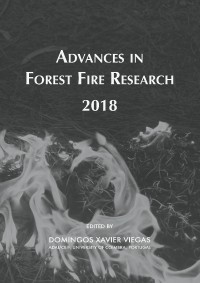Please use this identifier to cite or link to this item:
https://hdl.handle.net/10316.2/44559| Title: | Does prescribed burning reduce the amount of inflorescences in conifer forests?: implications for management in pure and mixed Pinus nigra stands | Authors: | Espinosa, J. De La Cruz, A. C. Madrigal, J. Guijarro, M. Carrillo, C. Diez, C. Hernando, C. |
Keywords: | litterfall;prescribed burning;Cuenca Mountains;defoliation;fire severity | Issue Date: | 2018 | Publisher: | Imprensa da Universidade de Coimbra | Journal: | http://hdl.handle.net/10316.2/44517 | Abstract: | Predictions of climate change project a future with an increasing incidence of fires. Prescribed burning, as a valuable tool for silvicultural management, might successfully reduce the severity and the intensity of subsequent wildfires, although with different effects on the individual tree. This is the reason why short term effect of prescribed burning in litterfall biomass is being evaluated in a network of experimental plots (18 plots of 50 m x 50 m) in pure (Pinus nigra Arn. ssp. salzmannii) and mixed (Pinus nigra 89% and Pinus pinaster Ait. 11%) stands in two sites (El Pozuelo and Beteta) of Cuenca Mountains. An experimental design with 3 treatments (with 3 replicates) per site were performed (spring and autumn burning and control) and 8 litterfall collectors per plot were installed after burning. Immediately after burning it was shown a short-term effect of prescribed burning in Beteta with an increase in amount of total litterfall in burned plots regarding unburned plots, although this effect was not significant in El Pozuelo there was an increase in needles. The increasing of total biomass (especially the amount of needles) could be an important effect determining the longevity of prescribed burning, especially in more productive ecosystems. Although, during the second year, the mean litterfall in burned plots is still higher than in control plots in Beteta, the differences have been reduced and the effect of fire has been weakened. The differences in the findings obtained between El Pozuelo and Beteta might be because of differences in pure and mixed stand structure. Spanish black pine (Pinus nigra) is a not serotonin species, and the persistence of the ecosystem is related to the productions of inflorescences and the later establishment. Some studies reported that prescribed burning reduces de emergence and increase the mortality of seedling during the first year. In addition, Pinus nigra presents regular cycles of fructification every 6-8 years which generate discontinuous pulses of natural regeneration. Prescribed burning two years before a pulse of fructification (maturation period of cones) could be critical to guarantee the regeneration. In fact, during the first and second year, and in the two zones, it was detected a decrease in the amount of inflorescences in the burned plots regarding unburned plots. In view of our findings prescribed burnings must be carefully planned in forest management, in particular when are aimed at regeneration in Pinus nigra pure and mixed stands, to avoid a negative impact of fire on the canopy. The possible dampening effect of the mixed stand is being evaluated too. The litterfall continues being monitored in and a complete database of litterfall in pure and mixed stands is being generated. Scarce information of the impact of fire in foliar and non-foliar biomass is available in Europe and more research is needed to confirm these preliminary results. | URI: | https://hdl.handle.net/10316.2/44559 | ISBN: | 978-989-26-16-506 (PDF) | DOI: | 10.14195/978-989-26-16-506_42 | Rights: | open access |
| Appears in Collections: | Advances in forest fire research 2018 |
Files in This Item:
| File | Description | Size | Format | |
|---|---|---|---|---|
| does_prescribed_burning_reduce_the_amount.pdf | 786.69 kB | Adobe PDF |  |
Items in DSpace are protected by copyright, with all rights reserved, unless otherwise indicated.
